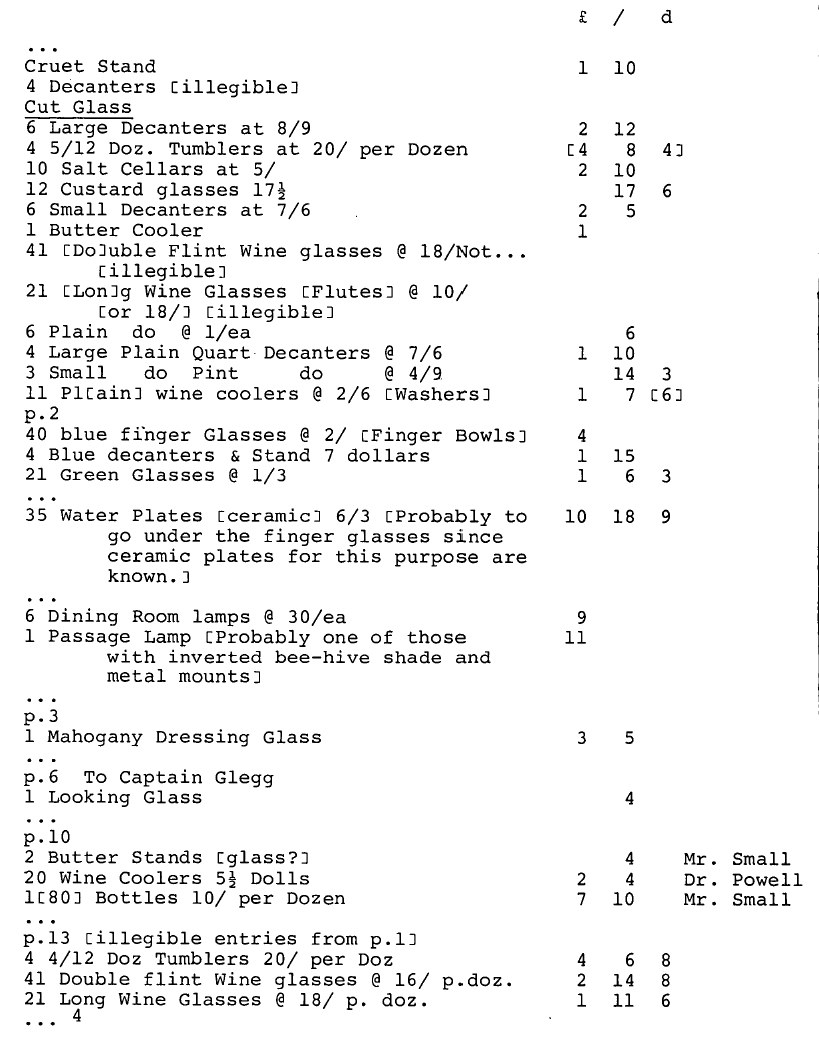Articles
Glass Used in Canada:
A Survey from the Early Nineteenth Century to 1940 Using Primarily Ontario Evidence*
Les anciens objets en verre sont difficiles à documenter en raison de leur fragilité, de l'absence de poinçon, de l'uniformité des motifs pendant de longues périodes et du retour fréquent aux anciens motifs. Le présent document passe en revue l'emploi du verre au Canada et se penche sur les changements de style des belles verreries faites à la main à partir desquelles furent reproduits des articles meilleur marché . il couvre quatre périodes: la période "Régence," de 1800 à 1835; le coeur de l'époque victorienne, de 1835 à 1880; la période "artistique," des années 1880 à la Première Guerre mondiale; et finalement, de la Première Guerre mondiale à 1940. Le verre moulé, reflet des goûts contemporains, fait l'objet d'un chapitre distinct. Même si la plupart des exemples proviennent de l'Ontario, ce document devrait constituer un guide pratique de consultation pour les autres régions du Canada.
Introduction
1 A number of factors should be considered before attempting to survey glass usage. As a category of historical artifact, glass presents many problems. It is very perishable and difficult to document since it represents only a small part of the early historical context as compared to architectural, archival, and furniture remains. Dating is often only approximate as, unlike ceramics, glass is seldom marked and the marks of manufacturing processes are only now gradually being studied. Styles and shapes that are well suited to the material and to the object's function frequently continue to be made for long periods of time. Old patterns are revived when there appears to be a market for them. Because of this and because the evidence for the use of glass in Canada is still incomplete, this paper will survey the subject largely on the basis of changing styles (especially British and American) in fine, hand-worked glass. The finest hand-worked specimens established the styles which were eventually copied and produced in more popular and inexpensive versions.
2 Although the references and illustrations are drawn primarily from Ontario examples, the initial section discussing evidence should prove helpful to researchers in other areas of the country. The following stylistic divisions are employed in considering the glass styles: 1800-35, which some writers would term loosely the Regency period; 1835-80, the mid Victorian period; 1880s to the First World War, the "Art Glass" period; and the First World War to 1940. Similar divisions have been used by other writers and despite a certain amount of stylistic overlap are accepted by most collectors. Pressed glass is discussed more or less on its own. As a mass-produced, machine-made product it is different from hand-worked glass, and although the patterns do reflect the taste of the times, its development is to a large extent autonomous and best discussed separately. Mirrors and lamps are also given a passing mention. This briefly sums up the terms of reference of this paper.
3 There are several ways of discovering what glass was used during various periods in Canada. Although early documents occasionally mention glass, the bulk of the documentary material dates from the last two decades of the nineteenth century. The most valuable documents are catalogues, from mail order companies such as Eaton's and trade catalogues from major suppliers of ceramics and glassware. Printed documents, for example, newspapers, may not always be reliable; occasionally the early printing blocks were poorly engraved or were commercially prepared ones representative of the type of product rather than the exact design of the merchandise. The names and nature of the merchandise also changed with the times: a "nappy," for example, would now be called a berry bowl or a dessert dish and finger bowls are no longer in fashion.
4 Pictorial evidence can be useful. Portraits, still life paintings, and sometimes photographs include glassware, especially vases of flowers. These can be dated by signatures, costumes, or if a photograph, by the photographer's address in an old business directory. A related pictorial source, popular prints such as those by the American firms of Currier and Ives or Louis Prang and Company, provide some evidence of the types of glass in use though the detail may not be accurate.
5 Some pieces of glass have been handed down as souvenirs from earlier generations, such as the "stirrup cups" and wine glass "washers" said to have once been the property of Lieutenant-Governor John Graves Simcoe and now preserved in the Grange, Art Gallery of Ontario. In certain cases the type of glass and its style tend to support such oral traditions. Items of glass that appear frequently in one region also suggest what might have been used at a certain period. The collecting of antiques is a relatively recent phenomenon. Most households will not systematically acquire old pieces and these are likely to have been handed down from the original owners. One must view this axiom with a certain amount of caution, though, as the retailing, importing, and gift-giving of antiques have drastically expanded in recent years and family oral history can be in error.
6 Sources of information that have not been fully exploited for the post-1835 period are the garbage dumps of old houses. These could presumably be located by a metal detector in the case of historic houses still on their original sites and would yield evidence of the patterns used in the household as well as the remedies, beverages, and condiments consumed.
7 Ceramics and glassware likely followed similar patterns of retailing and usage in early Canada.1 Both perishables suffered from the rigours of early water transportation and were sold by the same dealers. The early ceramics trade was channelled through distributors in Montreal and other large centres. Ontario became increasingly independent of such middlemen as water and rail transportation improved and the population grew and prospered. An auction was one customary method for distributors to sell tablewares. It was also customary for them to make up selections suitable for sale in general stores; the glass selections would likely have resembled those in ceramics which consisted of sturdy utilitarian material. Household requirements and usage would also follow those of the country from which the settlers had come. In the earliest years and in pioneering settlements, glass was found mainly in its most essential forms, such as windows,2 bottles, mirrors, and trade beads. When indigenous glassmaking began, its first products were window and container glass, items for which there was a strong local demand.
1800-1835
8 Fine ceramics and fine glass were not found in ordinary pioneer households but mainly in those of senior government officials, military officers, and prominent members of society. Early Ontario was a British colony, subject to the trade and navigation laws which gave British goods preference. Thus glass, like the ceramics used by Canadians in the early nineteenth century, was almost exclusively British in style and origin. This was particularly true in pre-Confederation days. Typical imported glassware consisted mainly of clear tableware, the best being cut lead glass with geometric and prismatic cutting. A lesser quantity of coloured glass, primarily in deep blue and deep green, was imported as stemware, washers, and decanters. Tableware shapes were simple, functional, and solid. A typical example is the decanter (see fig. 1) said to have come from the Maritimes. The stopper was pressed in a small hinged mold and the body mould-blown with a suggestion of cut flutes impressed around the base. Such a piece may be of northern English or Scottish origin and could easily correspond to the "4 Large Plain Quart Decanters @ 7/6 [each]" from the estate of Sir Isaac Brock (see below). A similar pint decanter, said to have descended in the family of a shopkeeper in eastern Ontario, has recently been donated to the Royal Ontario Museum.3 Other examples of early glassware with a family history will no doubt come to light.
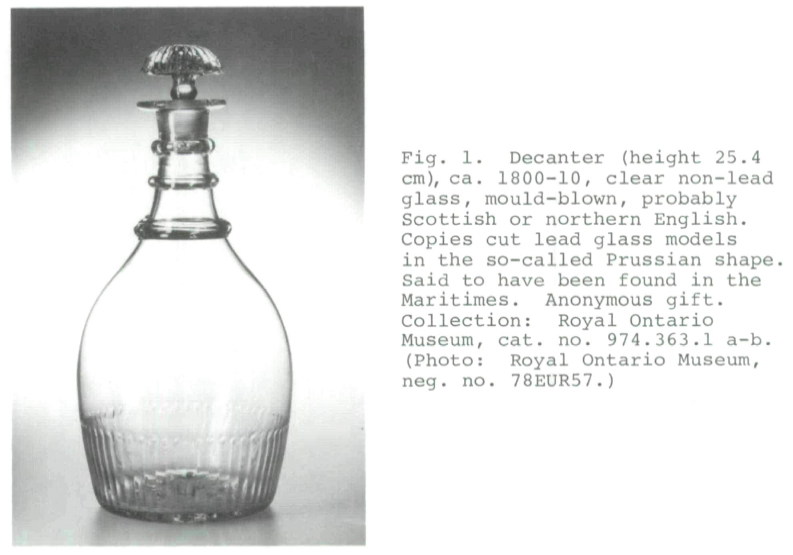 Display large image of Figure 1
Display large image of Figure 19 Examples of typical early glass are given in this inventory of goods belonging to the estate of the late Major-General Brock, November 1812. Only the glassware is printed here; all other items have been omitted.
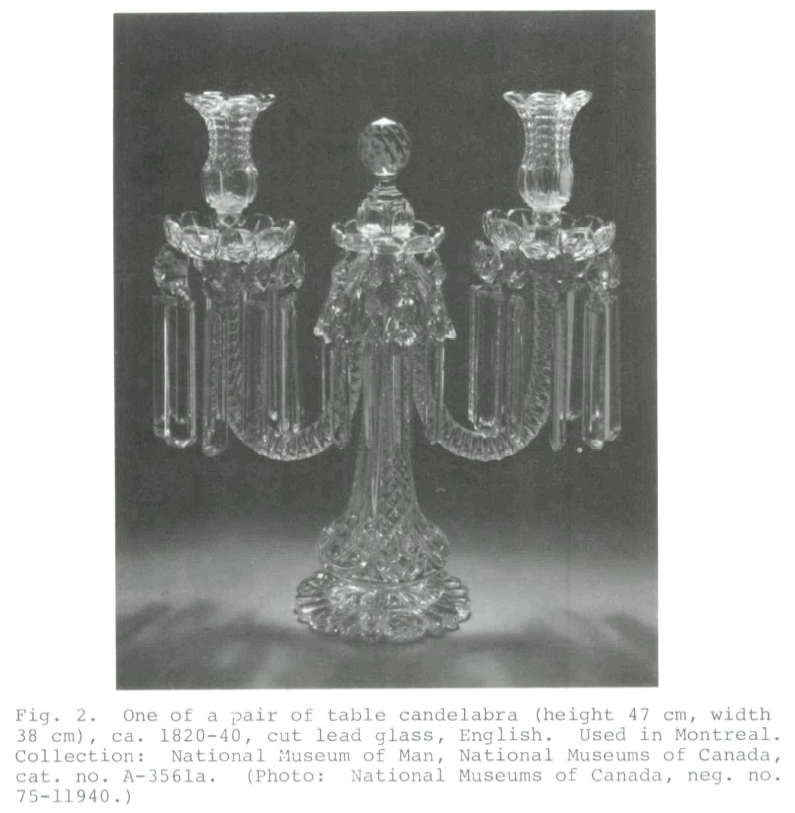 Display large image of Figure 2
Display large image of Figure 21835-1880
10 As early as the 1820s tendencies to richly coloured and decorated glass had been developing in Bohemia and France, possibly as a reaction to the fashion for clear and brilliant British cut lead glass. The taste for lead glass did not die out (see fig. 2); it was merely paralleled by a growing demand for coloured glass. Some writers have seen the 1845 repeal of the glass tax in England as a stimulus for the increased production of new luxury lines. No doubt the Great Exhibition of 1851 in London, England, which featured considerable continental glass and the ostentatious bourgeois taste of the times, was equally to blame.
11 The best of this glass relied on a variety of techniques. New chemical colours were introduced, for example, shades of yellow and pale green produced by the use of uranium. Some of the colouring was created by transparent chemical stains fired on the surface of clear glass; amber was produced by silver nitrate and ruby by manganese. Overlays or coatings of glass were also favoured, usually over clear glass. These might be combined and intensified with an under layer or an interior layer ("casing") of opal glass. Cutting could be executed through the coloured layers and was frequently in the form of somewhat gothic cartouches and quatrefoils. All this could be combined with gilding, usually floral or arabesque, and naturalistically painted flowers or figures. The shapes of the 1850s included a preponderance of classical urns, jugs (oinochoai), ewers, amphorae, baluster vases, and tazzae. Panelled octagonal and hexagonal shapes were also found in glass, for example, decanters, perfume bottles, and ornamental beakers, as well as ceramics, especially ironstone "flow blue" jugs. There was frequently a tendency to heaviness and richness, sometimes with a suggestion of the Middle East and India which were popular markets for this glass.
12 The best of the "Bohemian style" glass is characterized by fine finishing and quality materials. Poorer pieces probably date from a later period. The deep red stain, used to decorate glass from about 1850 to 1910, is a good example of the tendency to cheapen techniques. Mid Victorian examples, such as souvenir beakers with views engraved on bosses, are of good quality clear glass with the surfaces carefully wheel-polished before staining. By 1870 decanters, perfume bottles, and stemware of poor quality blown glass appear; these have grape vines wheel-engraved through the stain with varying degrees of competence. About 1900 this stain was largely reserved for inexpensive pressed glass, engraved with names or souvenir mottoes and sometimes sold at fairs or exhibitions. Today a poor quality of this stain is occasionally used for traditionally styled tablewares.
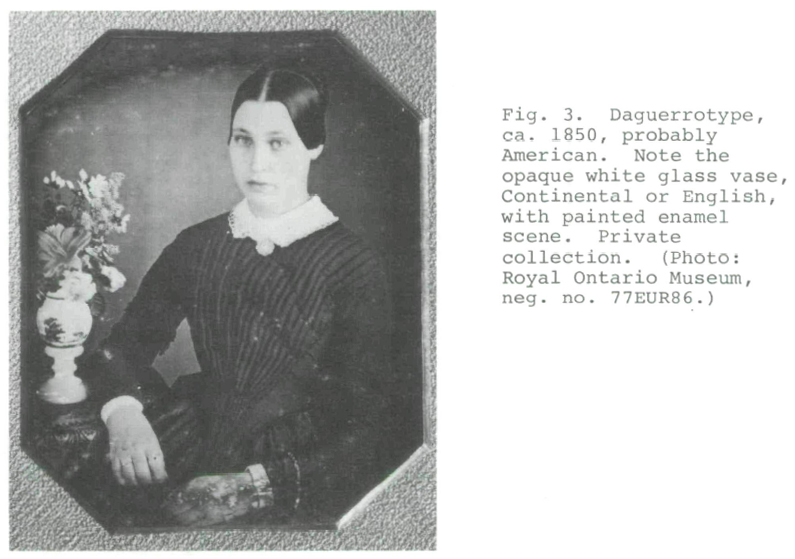 Display large image of Figure 3
Display large image of Figure 313 Mid Victorian vases and serving pieces were also made in opaque glass with a mat surface suggestive of alabaster. Vases in glossy opaque white glass, painted in naturalistic colours and/or gilt designs, were popular decorator items from about the 1840s (see fig. 3). These seem to have come from Bohemia as well as England. Mid Victorian examples tend to have more bulbous, classical bodies and are sometimes in pairs. Examples of the 1870s and 1880s are usually fairly cylindrical. Later examples also are frequently found in glossy pale pink, turquoise, pale green, pale mauve, brownish grey, and black. This last colour was likely known as "jet" since the Victorians customarily named colours for gemstones. On later examples the decoration is often painted in a broad splashy manner, in rather unnatural colours, usually with assymetrically arranged motifs, and on less well made pieces in a combination of white enamel outlines overpainted with oil colours. Flowers and cranes predominate among the later decorations. The poorest and latest examples of this tradition are those in thin, bubbly, semi-opaque glass with a frosted finish. Although dealers frequently refer to all of these opaque types as "Bristol," it is likely that almost all the English examples came from the Stourbridge area with others coming from the Continent and various American factories.
14 During the period 1835-80 some Canadian homes could have had quite fine glass. In 1856 the auction of the goods of lawyer William Hume Blake included the following lots:
115 Set of candlesticks with lustres
121 Flowers and shade
125 Eau de Cologne Bottle and 2 matts5
The epergne, like many table serving pieces, would have combined glass with metal; a shallow clear glass bowl, cut and/or frosted, would sit on a silver-plated stand.6 The Blake example would have been made sometime after 1840, when electroplating was introduced with great success in England, and might have been made by its leading exponent, Elkington and Company of Birmingham. Several themes recur among the epergnes: one is the neoclassical tripod base of the late 1860s-1870s, with or without suspended chain garlands, and the other is the palm tree or other tree supporting a bowl above a plateau with figures, ca. 1850-80.7 The glass containers found in these and other silver-plated mounts would likely be clear before 1880.
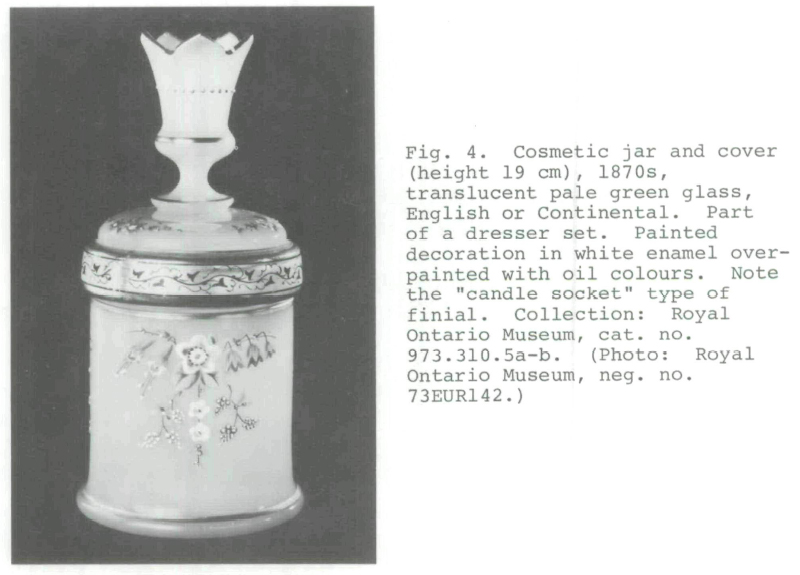 Display large image of Figure 4
Display large image of Figure 415 The set of candlesticks with lustres listed in the Blake effects may have had cast metal mounts, possibly rather flat figural supports with a gold tone finish. These would be set on marble bases with circles of prism-cut glass pendants suspended around the figures. Such sets, consisting of a pair with one or two candle holders, were often completed by a central one with three candle holders. These mantel "garnitures" were American- or English-made. The candlesticks might also have been vase lustres.8 These were large, goblet-shaped vases in any of the kinds of coloured glass mentioned earlier; the "lustres" were the cut glass prisms. Vase lustres sometimes contained removable metal candle sockets. The vogue for vase lustres on the mantel lasted ca. 1850-80 and Bohemia and England seem to have produced most of them.
16 From approximately 1845 to 1900 glass domes ("shades") were used frequently over arrangements of artificial flowers, stuffed birds, clocks, and fancy figurines. Decorative perfume bottles, alone or as parts of dresser sets, were made throughout the latter half of the nineteenth century. The panelled shapes are the earliest; ones with "candle-socket" stoppers seem to have been part of dresser sets around the 1870s (see fig. 4).
17 The period 1850-80 saw a number of other changes in glass usage worth noting. The mirrors of the early nineteenth century had usually been small. Pier glasses, tall rectangular mirrors which hung between windows in fine drawing rooms,9 sometimes had a small upper panel of reverse painting on glass. Overmantel mirrors, also found in the best homes, were usually rectangular, horizontal, and sometimes divided into a wide centre section flanked by equal and smaller side sections. By the 1850s larger panes of glass were being made and the typical overmantel mirror became a large, arched affair with cast and gilt plaster ornamenting the frame. Pier glasses also became larger and longer and often had a low table at the base. From the mid Victorian period to ca. 1910 mirrors were built into display areas on pieces of furniture; fine, bevel-edged mirrors are particularly noticeable on factory-made buffets, desks, and pump organs from the 1880s.
18 After the introduction of inexpensive and safe kerosene in the late 1850s, the use of glass lamps became more widespread.10 Gas lighting fixtures, used in urban areas from this period onwards, were decorated with glass shades and ornamental fittings. Almost all the glass lamps used in Canada seem to be American, made in American moulds, or English. Certainly many of the later lamps used ca. 1900 were made in Canada and lamp chimneys, which continually needed to be replaced, were also made here; however, one should not automatically assume that lamps found in Canada, especially those before 1880, are Canadian-made.
19 In anticipation of the post-1880 period, there are two other developments to note. Simple, blown, clear glass table-wares with wheel-engraved or etched decoration were becoming popular. The British art critic John Ruskin had criticized the spikey cut glass monstrosities shown at the Great Exhibition of 1851 and this in part led to simple, flowing designs. Examples of these are illustrated in the Boston & Sandwich Glass Company Catalogue of 1874.11 This catalogue also includes a surprising number of drinking glasses following models that were introduced earlier, a fact which suggests that many everyday types of glassware did not change that often. Another feature of this catalogue is the large number of clear and painted opaque glass flower vases, epergnes, and jardinières. These indicate the interest in plants and flowers that was prevalent from the 1870s to the First World War.
20 A second development was the introduction of special patented processes for glassmaking, for example, "mercury glass," a hollow blown glass with an interior coating of mercury. When first introduced in the 1850s the body was made of a fine, heavy glass. By about 18 80 it had become a cheap, decorator glassware made by English, American, and Continental (largely central European) factories. Later pieces included candlesticks and vases of long baluster form with poorly painted flowers. Christmas ornaments are survivors of this tradition.
Pressed Glass
21 The United States was a supplier of glass to the Canadian market due to its close proximity and marketing methods. Glass-workers frequently travelled between the two countries, further aligning their styles. Examples of American "South Jersey" glass [editor's note: see p.43, note 1, for explanation of this term], such as those attributed to Mallorytown, are found in a Canadian context as is American pressed glass. The number of examples of American glass found in Canada may have been diminished by American antique dealers and collectors over the years.
22 American pressed glass is of key importance in documenting the development of pressed glass manufacturing and patterns. It has been well studied and illustrated by several researchers, including Lowell Inness, Ruth Webb Lee, George and Helen McKearin, Alice Hulett Metz.12 Surviving examples suggest that the British did not successfully pursue glass pressing until about 1870. The Americans introduced glass pressing for drawer pulls and "cup plates" ca. 1825-27.13 Glass pressing may have appeared earlier in Belgium or France; however, it is American pressed glass which is the best documented.
23 Essentially the pressing process consists of forcing molten glass to fill a heated iron mould by means of a plunger. The size of the pieces and the range of colours grew from the 1830s on. Early patterns either were copied from cut glass or were variations of scroll and stipple motifs which have come to be called "lacey Sandwich" because the Boston and Sandwich Glass Company made many such patterns. Commemorative and figurai pieces were also produced. Many of the finely-pressed plant, figurai, and novelty patterns are American dating from the 1870s onwards. American pressed glass of the 1860s and earlier is often distinguished by its heaviness, thickness, and durability. Pieces such as those listed in the advertisement below were frequently well-finished, that is, mould seams were fire-polished and feet were wheel-polished. The most typical product of this period is the panelled tumbler. Later pieces of American pressed glass can be of lighter material. The following notice from the Hamilton Daily Spectator & Journal of Commerce of 25 September 1852 provides some idea of the extensive range of American pressed glass imports:
THE SUBSCRIBERS WILL SELL BY AUCTION, at the Stores of the Agents, Messrs MILLAR, GLASSFORD & Co., No. 5, St. Sacrament Street, Montreal on Tuesday, 28th September-406 Casks Assorted Glassware, first quality, manufactured at the Works of the Boston and Sandwich Glass Company,
COMPRISING:
Punty Bowls, on feet; Spangle and Pannel [sic] Dishes; do Bowls on feet, Jugs; Bedford, Providence, and other lamps; Cone, Egg and Concave Hall Lamps, Bronze Mountings; Napies, with and without covers; Quart, half gallon and gallon Specie Jars; Ice Cream Glasses, Salts; Mo-flu and Spangle Bitter Bottles; Brit. Tubes; Astor and Revere Champagne Goblets; Egg Cups, Jellies and Celleries; Gothic, Arch and Ashburton Lemonades; Astor and Ashburton Wines; Spoon Holders, Cup Plates and Candlesticks; Punty and Sp. Knob Ale Glasses; Spangle and other pat. Decanters; Castor bottles (assorted); Molasses Jugs and Mustards, Brit[annia metal] covers; Tumblers in great variety of weight and Pattern, &c. &c.
Also
An assortment of Druggist's Ware; Terms:- Six months' credit on all accounts exceeding £25. Catalogues will be ready for delivery, and samples on view, on the 20th September. Sale at TEN o'clock.
By the 1870s English pressed glass was appearing on the Canadian market as is indicated by pieces with English registration marks and trademarks found in a Canadian context. Most of this English pressed glass consisted of small vases, spill holders (cylindrical vases for twists of scrap paper used for lighting lamps and candles), and novelty items in opaque, glossy, coloured glass. The few pressed glass patterns commemorating Canadian events are later and mostly English made. The Marquis of Lorne pattern was introduced by Henry Greener of Sunderland early in 1880 (see fig. 5).15 The various Jubilee commemoratives were also English. The producer of the so-called "Beaver" goblet is yet to be identified.
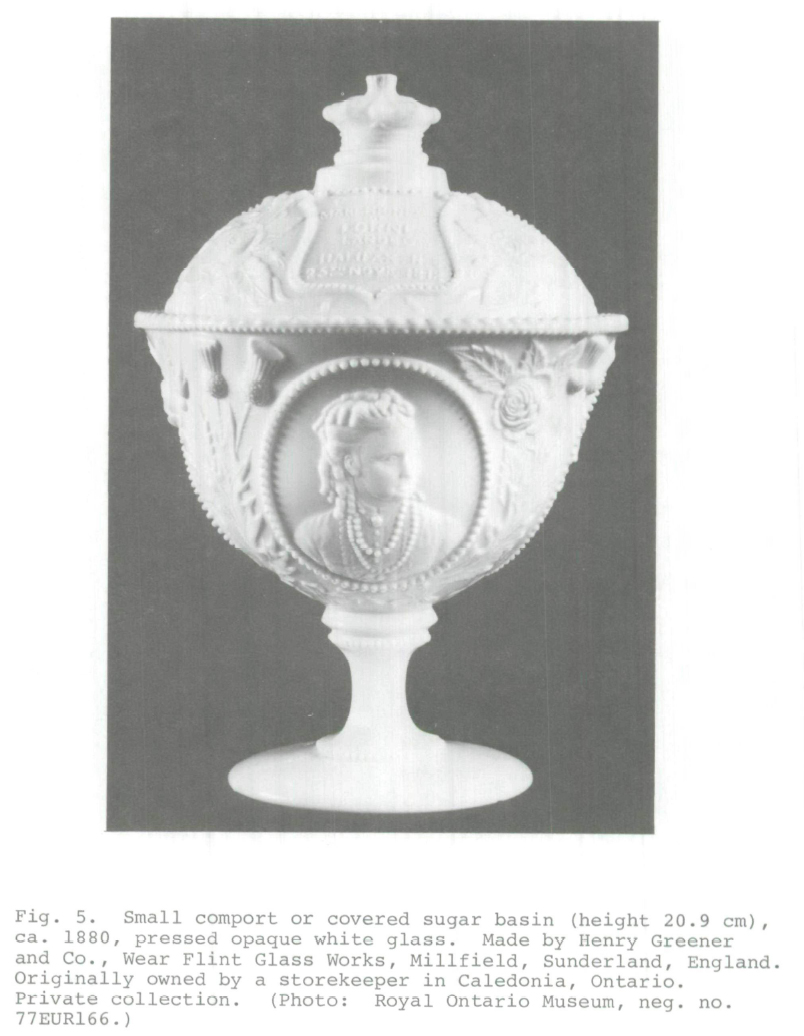 Display large image of Figure 5
Display large image of Figure 5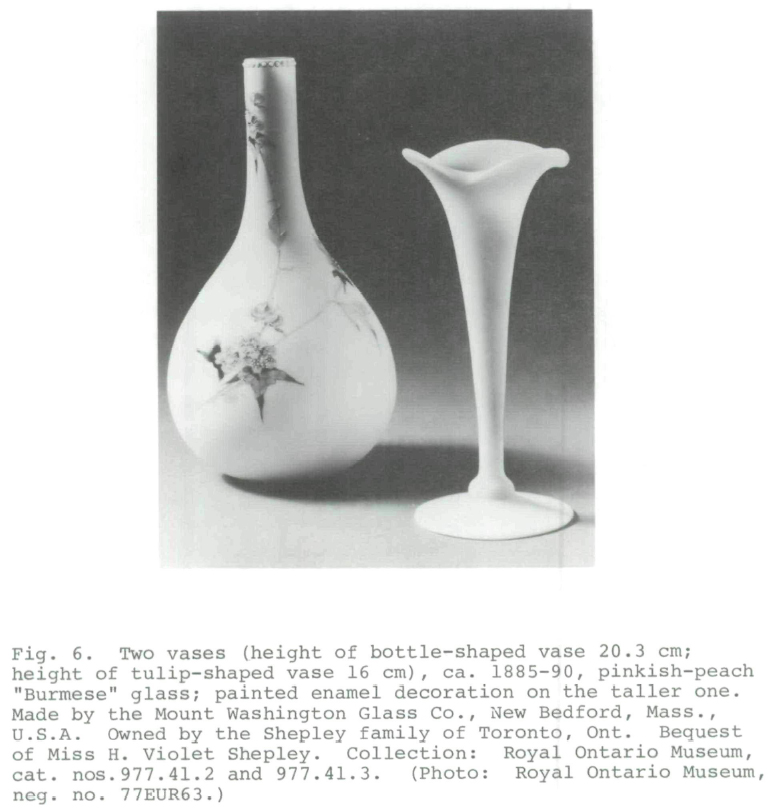 Display large image of Figure 6
Display large image of Figure 624 In 1879 tariffs were introduced to protect the Canadian glass industry and so began its major period of pressed glass production which lasted until the 1930s. There is still much that needs to be done to clarify which patterns were made in Canada and in what types of glass. Recent research would tend to indicate that many of the patterns, at Burlington Glass Works, for example, had been made earlier or were being made concurrently in the United States. Preserving jars, medicine bottles, and popular beverage bottles were mass-produced items which figured increasingly in the Canadian market from the 1870s.
1880s to First World War
25 The 1880s mark the beginning of the so-called "Art Glass" period. This was coloured glass produced for its decorative and artistic value. The best examples, such as "peach blow," "Burmese," mother-of-pearl, and satin, relied on quality materials, fine workmanship, and catchy names. Chemicals and chemical processes, for example, acid-finishing with hydrofluoric acid to give a mat surface, were extensively utilized in the production and decoration of this glass. The best of the art glass was produced in England, France, and the United States. The shapes were rounded and often copied oriental ceramics; the colours were pale and pastel, the decoration often restrained and assymetrical (see fig. 6). Some of the more common survivors of this Art Glass period are vases (singly or in pairs), small baskets, centrepiece bowls with ruffled edges in electroplated mounts, lamp shades, rose bowls, biscuit barrels, and pickle cruets.
26 Less expensive grades of coloured glass were produced by Bohemian and British factories. The enamelled wares, such as lemonade sets (pitcher, six glasses, with optional tin or glass tray), and vases with figures of children,16 seem to have been almost exclusively Bohemian products (see fig. 7). Sometimes the coloured glass was decorated with applied clear glass, copying Venetian models of the fifteenth and sixteenth centuries; for example, ruffles of applied "fly wings" were popular in the period 1885-1915.
27 Eaton's catalogues were first published in 1884 and by 1887-88 offered a fair survey of popular glassware in electro-plated mounts. Initially this was almost all pressed or inexpensive decorated glass; over time a greater range of coloured and hand-worked glass was evident, and the price range suggests that everything from popularly priced art glass to the cheapest pressed glass was on hand. The catalogue listings can be interpreted as indicating items which were already well received by the public and for which there was a ready market.
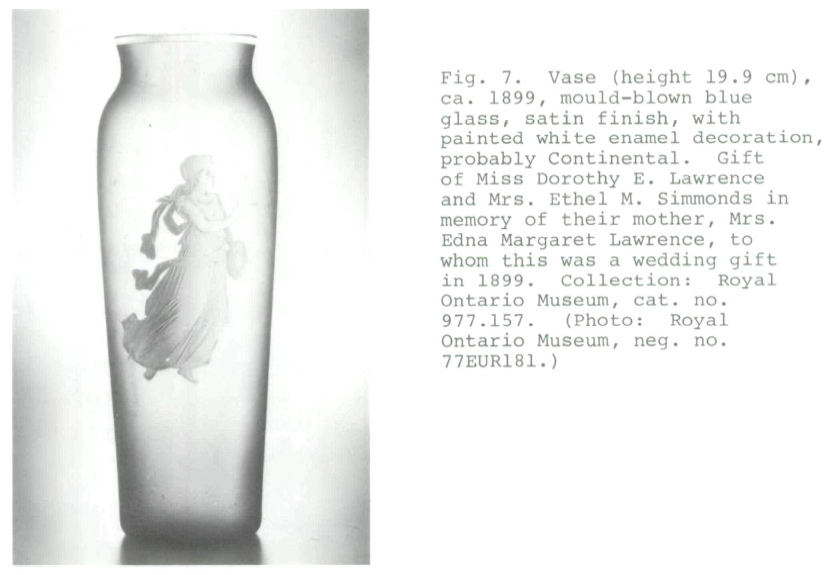 Display large image of Figure 7
Display large image of Figure 728 Certain standard models of glass in electroplated mounts continued to be stocked over long periods of time. Eaton's catalogues indicate that the standard pickle cruet, a cylindrical glass container with metal base, hoop handle, cover, and pickle tongs on a hook at the side, was popular from the 1880s to about 1920. Glass biscuit barrels with metal mounts were popular until a slightly later date. The dinner cruet with a weighted base and rotating ring holding five or more condiment bottles was sold from the 1880s until the First World War, the same period in which coloured glass bowls and baskets with ruffled edges set in electroplated mounts were popular. All of these items have been reproduced in the last ten years by American manufacturers of silverplate, usually with garishly coloured glass and poorly painted decoration. Catalogues ca. 1900 show biscuit jars and shakers in American "Wave Crest" glass, a thick, white glass with surface relief and delicately painted flowers. Although some of this glassware in electroplated mounts was sold by Canadian manufacturers, it just as easily could have been imported since manufacturers used whatever was cheapest and most attractive and since tariffs were lower on component parts assembled in Canada.17
29 Eaton's Fall and Winter Catalogue for 1892-93 featured the new glass and china department in the basement of the Toronto store which carried a full range of wares.18 The catalogue advertised the following items: high and low berry dishes; biscuit jars; bouquet holders (probably small trumpet vases for nose-gays); odd castors; celery jars, trays, and stands; cheese dishes (covered dishes); cream jugs; three-to-five-bottle cruets; custard cups with saucers; low fruit dishes; high fruit dishes, on stand, with or without cover (probably comports); nappies to match the fruit dishes; goblets, plain and moulded or moulded and engraved, plain flint, or simply engraved; individual creams, sugars, butters, salts, and salts and peppers with nickel tops; jugs; lemonade sets; marmalade jars; molasses jars, crystal (clear pressed glass) with nickel spring top and in colour; mustard pots; pickle jars with and without nickel handle; pickle dishes; preserve, candy, or bonbon trays; oil and vinegar bottles; rose bowls; salt and pepper shakers; sugar shakers (a large shaker, used for sweetening desserts); tea sets (cream jug, sugar bowl, spoon holder, and covered butter dish); and tumblers, moulded and plain. All items were carefully listed with sizes and a range of two to five prices. Goblets varied from four to thirty-five cents each. Coloured glass was generally more expensive; the cheapest item was individual salt dishes at twenty-five cents a dozen and the most expensive was a lemonade set at $2.75. Although entries in successive Eaton's catalogues were similar, the range and variety was gradually reduced to only a few lines for which there was evidently a good mass market.
30 Undoubtedly there were many expensive or unusual lines of glass that were not sold by Eaton's, even on a special order. One of these was iridescent glass which likely was stocked in only the simplest commercial lines. Iridescent glass, which has a shimmering rainbow finish created by fumes of tin fluoride and meant to suggest the surface decay on ancient glass, came into vogue during the 1890s. Louis Comfort Tiffany's "Favrile" glass (post-1893) with its flowing organic shapes is a leading example of this type and of the Art Nouveau style. Tiffany glass vases and tablewares have descended in some prominent Canadian families and may have been received as gifts from the United States or purchased during visits there. Tiffany lamps and stained glass windows, especially in churches, are also found in a Canadian context.19 Cheaper iridescent vases came from Bohemia, the best being from the Loetz Witwe firm, and from England. The most frequently encountered examples of iridescent glass are the bell and drop-shaped lamp shades, with or without feathered designs, found in brass electric fixtures from 1900 to 1925-30. Made by the Steuben Glass Works, Corning, New York, the Quezal Art Glass Company, Brooklyn, New York, and a number of other American firms, these were among the earliest electric fixtures in general use. The inexpensive "Carnival" glass, a pressed glassware with iridescent orange, blue, or greenish finish, was produced in the United States ca. 1900-30 with sporadic revivals of poor quality wares since then.
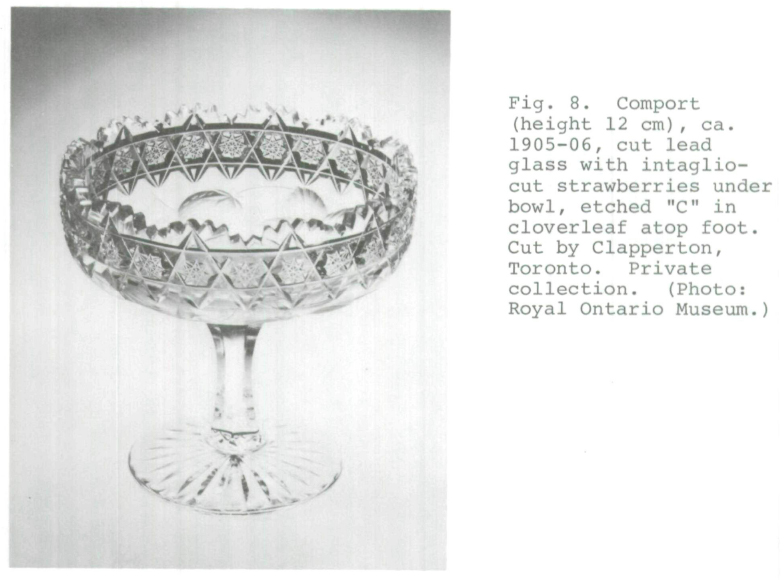 Display large image of Figure 8
Display large image of Figure 831 One of the major developments in the Canadian glass industry about 1900 was the growing popularity of cut glass. The taste for richly cut lead glass for the table had been developing from the 1880s onward and American manufacturers such as Hawkes, Libbey, and Dorflinger had taken the lead. Cutting shops came into operation in Canada with the uncut "blanks" being imported from Belgium, France, the United States, and possible England.20 In Toronto Roden Brothers and Gundy-Clapperton (from 1906, founded as Clapperton in 1905) produced fine work (see fig. 8). Glass cutting shops were set up even in small Canadian centres.21 Some of the best work was done for the firm of Henry Birks and Sons. The pieces tend to heavy and geometric designs in a fine precise style during 1900-10; floral designs and poorer standards of workmanship are evident after 1910. By the 1920s the fashion for cut lead glass was fading. Workmanship was poor, designs were either entirely or partly pressed into the blanks, and coloured stains were occasionally used. American, Canadian, and some British cut lead glass is identifiable by small frosted trademarks etched into the glass, usually on the bottom. Examples from three Canadian firms — the maple leaf of Gowans Kent, the large gothic "R" of Roden Brothers, and the Gundy-Clapperton three leaf clover lettered G/C/C — are frequently found. A very cheap quality of cut glass with similar designs to Canadian came from Bohemia.
32 Another item that fits into the same context as Canadian cut lead glass is what Eaton's Fall and Winter Catalogue of 1913-14 called "THE VERY POPULAR DEPOSIT-ART WARE."22 This refers to pieces of glass and ceramic with a design electroplated in silver on the surface. Like cut lead glass, the vases, cruets, teapots, and cream jugs were supplied by non-Canadian makers. These "blanks" seem to have been of rather utilitarian quality; the tea sets, for example, were brown or green "Betty" stoneware. The Montreal China and Glass Decorating Company is known to have made such ceramic wares from a number of marked teapots and tea sets datable to 1899-1911;23 unfortunately no glass with silver deposit has been found with the company's mark. Various American manufacturers did similar work during the same period and some of their better pieces bear the impressed mark "Sterling" with trademarks. Periodic revivals (ca. 1935 and ca. 1955) of silver deposit decoration, especially for pressed glass, usually feature small, tight, floral and plant motifs as opposed to the broad flowing tendrils of the Art Nouveau period.
First World War to 1940
33 By the twentieth century Canadians had developed a cosmopolitan taste in glass; Continental, American, English, Canadian, and even Far Eastern glass could be found in their homes. Some of this foreign glass came in as a result of travel abroad; such was likely the case with French cameo glass ca. 1900, such as that of Galle, Daum Frères, Muller Frères, and other luxury manufacturers.
34 Stylistic development in the period 1910-20 was slowed by the war. Many types of iridescent and cameo art glass continued to be made. Simpler flowing lines of stemware with lighter decoration were favoured; these were either needle-etched or, by the 1920s, wheel-engraved in simple patterns like "Cornflower." After the war shapes of vases and other ornamental pieces became simpler and more solid. Colour with a texture or with mottling, such as that found in "Le Verre Français" produced by Charder or in the work of Daum Frères (see fig. 9 ) , was also popular. "Alabaster" lampshades introduced around 1910 were another example of texture. The glass of René Lalique of France, produced in quantity ca. 1922-39 and marked "R. Lalique" during this period, is the epitome of the style of the 1920s. Here the interest in texture is created by opalescent tints and frosted surfaces sometimes rubbed with oil pigments; coloured glass, including a solid black, was also used. With its sculptural, flowing reliefs Lalique glass forms a transition between Art Nouveau and Art Deco or Style Moderne as it was sometimes called. Lalique glass also satisfied a certain luxury trade and was sold by prestige stores such as Morgan's in Montreal. The fashion in glass ornaments used in interior decoration was the single significant object as opposed to late Victorian clutter. Lalique glass and its many imitations fulfilled this purpose.
35 By 1930 the tendencies of the 1920s toward colour and floral or figurai design in fine glass were waning. Under the influence of Swedish glass, especially that of the Orrefors factory, a new emphasis on the optical beauty of clear glass appeared, and this was enhanced by carefully placed, thickened sections or wheel engraving. Simple linear or geometric ("Cubist") cutting and textured surface effects were becoming more usual as decorative treatments. Shapes were simpler and more monumental. Funnel forms, low or elongated, seem to characterize the period. Sometimes this funnel shape or the typical stemware with a thin light body was enhanced by a foot in darker glass — black or green. Stemware of thin glass, wheel-engraved with flowers, grapes, and other motifs, was popular up to 1940. Venetian glass, both in interpretations of simple traditional forms and in updated versions of coloured "façon de Venise," was also being produced. Bubbly green glass in the "South Jersey" style began to be imported from Mexico.
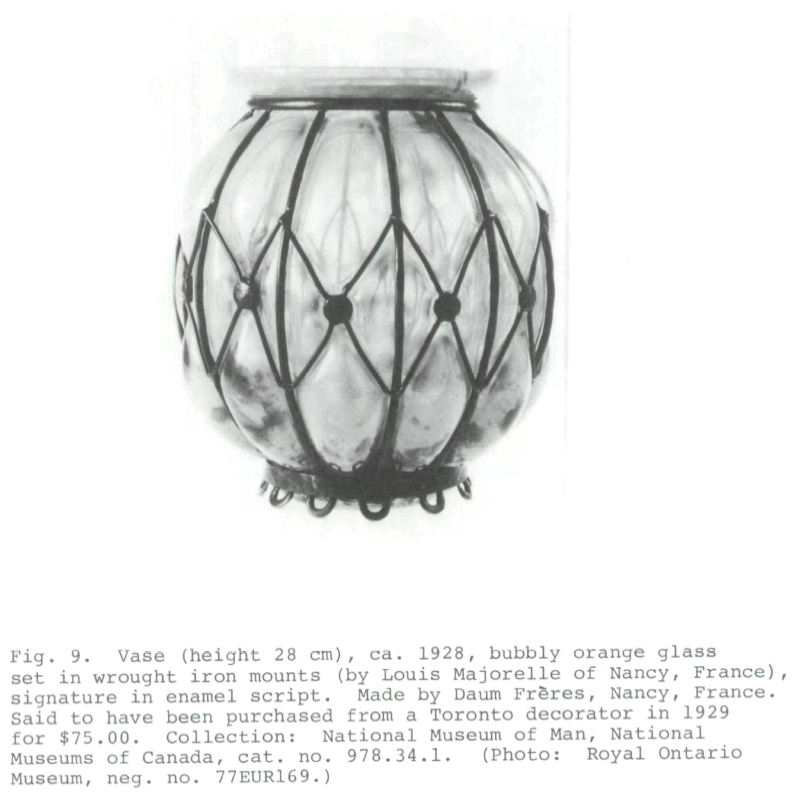 Display large image of Figure 9
Display large image of Figure 936 Among the contemporary glassware donated to the Royal Ontario Museum in 1941 by Mrs. Josephine Eaton Burnside, member of a prominent Toronto family, were two Lalique vases, "Monnaie du Pape" in mauve and an opalescent cylinder vase with relief laurel leaves; a low bowl or ash tray with bubbly black inclusions by Henri Navarre of France; a pale yellow, funnel-shaped bowl by Daum Frères, Nancy; two cube vases in pale, bubbly orange, and green "vetro sommerso" by the Venini factory in Murano; and sixteen overlay glass wines and liqueurs with fine traditional intaglio cutting by Stevens and Williams of Brierley Hill near Stourbridge, England. Judging from the naturalistic decoration and colour (which were less fashionable ca. 1940), the bulk of these items could have been acquired ca. 1930-35. The mixed patterns of the stemware and the attached trade labels suggest that they might have been store samples. Mrs. Burnside's material gives a fair indication of well-to-do Canadian taste in fine glass during the period.
37 The most popular cheap glassware was the so-called "Depression Glass." This was a machine-pressed American tableware often decorated with raised linear flowers and figures reminiscent of needle-etched designs and produced in pale green, dark blue, black, clear, shades of amber, and "rose-pink."24 Its production stretched from the 1920s through to about 1940 and is well documented by recent American pictorial publications. Depression glass was a popular premium given in boxes of soap, at the movies, or at service stations. Similar designs also appeared in pyrex ovenware which was introduced in the 1920s.
38 The glass used in Canada after 1940 is easily documented. Examples of it are still found in many homes and illustrated archival resources are readily available. Many of the designs introduced in the period 1920-40 are still in production. Oddly enough this date also signals a similar taste to that described for the first period mentioned in this paper, 1800-35, when the best glass was clear with coloured glass being a secondary part of the production. And, just as the 1835-80 period reacted to this "clear" phase, so also today we have a large production, mostly handwork from studios, of coloured glass in reaction to the clear glass of the pre-1940 period.
* Based on a paper presented at the OMA-ROM seminar "Glass in Canada: Its History and Study," Toronto, November 1977.
1896-98 - Montreal China Decorating Company
1899 - Montreal China and Glass Decorating Company, 559 St. Paul
1911 - not listed
1913 - Glass and China Decorators Ltd., 1532 Bordeaux
1920 - Jacob Gelz, Alfred and Charles, 1532 Bordeaux
